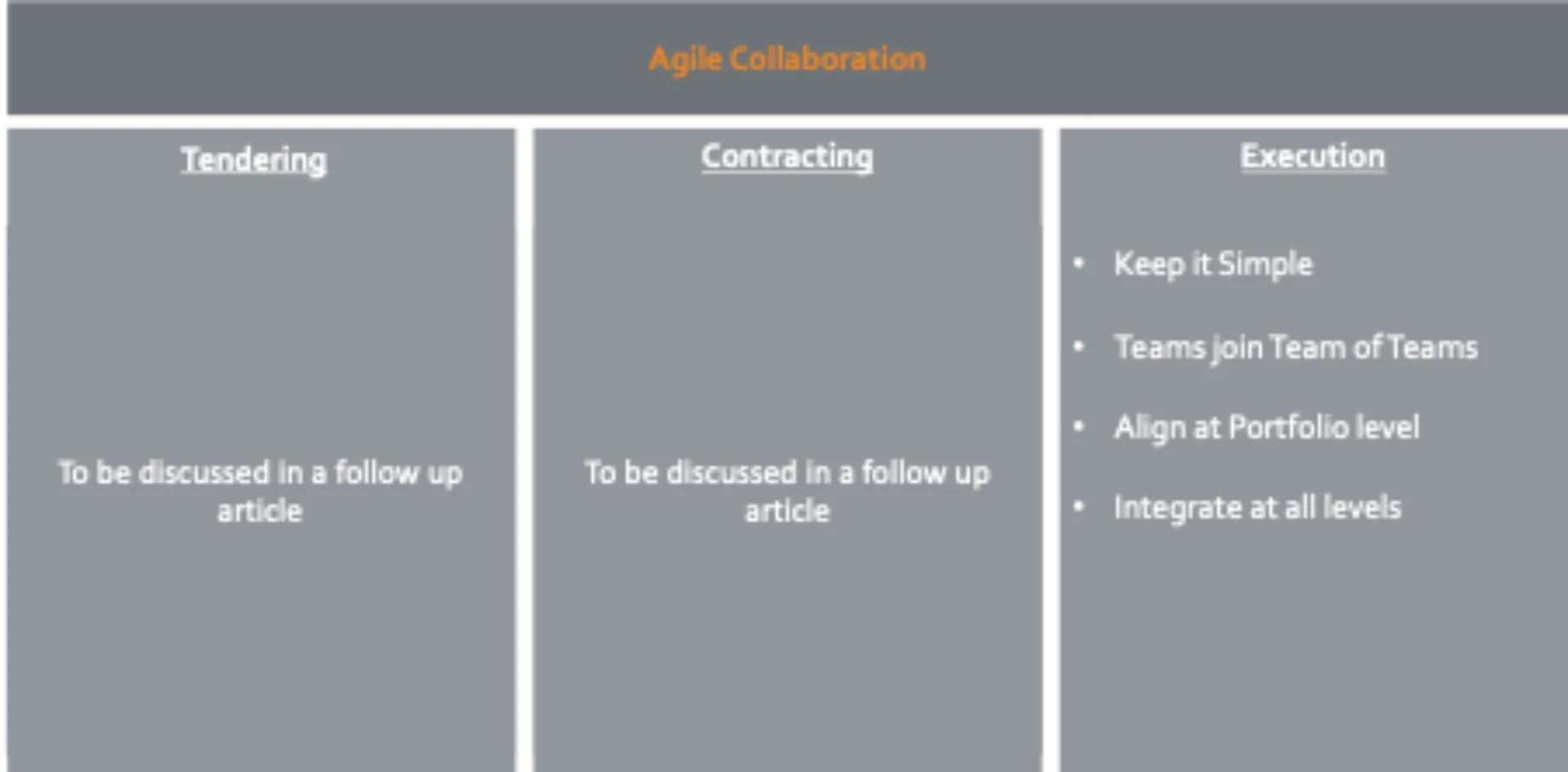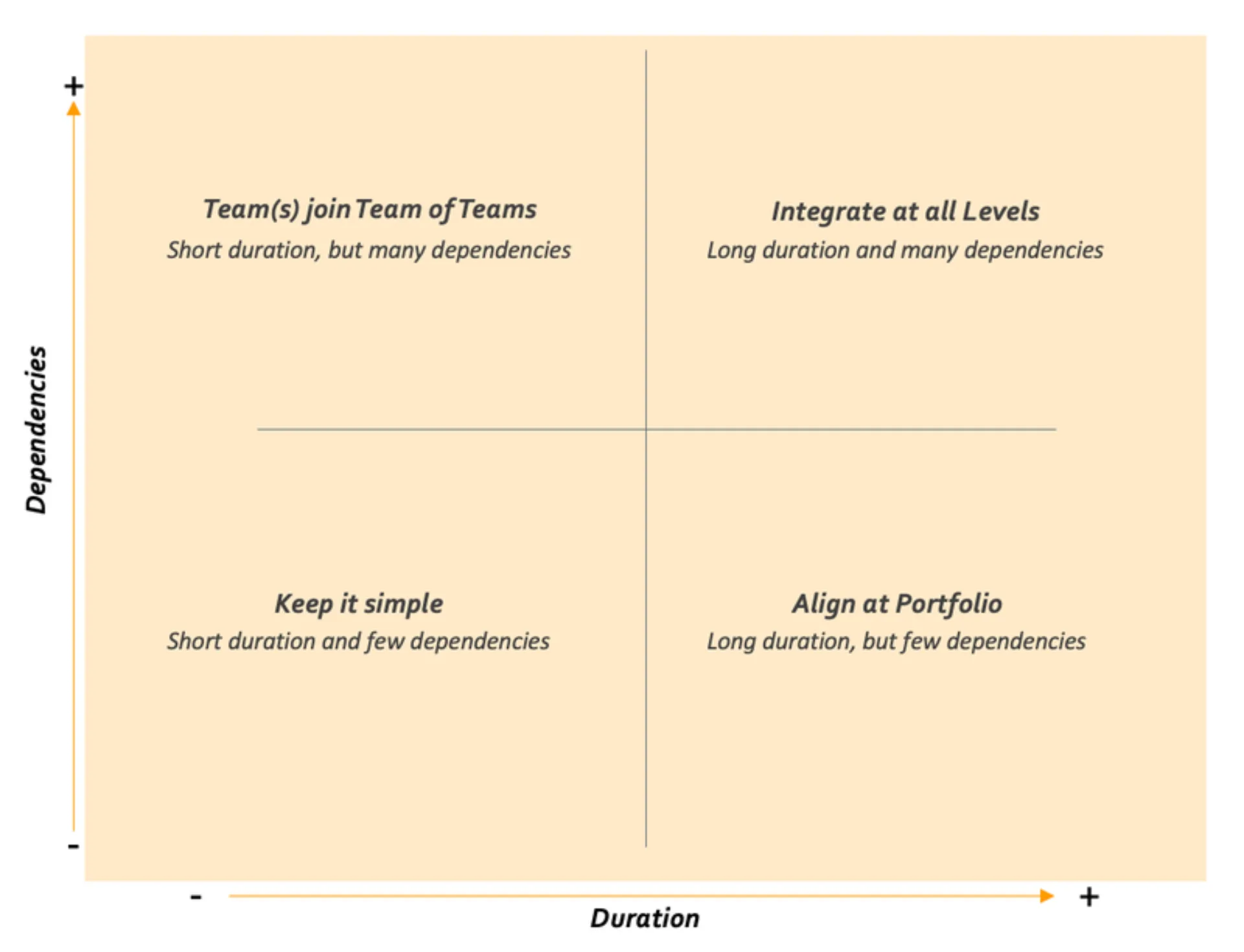Mastering agile supplier collaboration
You are amid your Agile transformation. Teams are working Agile; teams of teams are effectively managing their dependencies, and your portfolio management is transparent and gives direction to the teams. You are continuously improving, and yet, while you have made progress regarding your speed of delivery, you are still experiencing delays in your end-to-end delivery. In the current era, end-to-end delivery often means that somewhere along the process of value delivery, you need suppliers. This can be in the form of essential physical or software components, expertise or resources. It is therefore not strange, when performing a root cause analysis or any other method you have used to tackle impediments, you come to realize that you suffer from misalignment with your suppliers. Examples are that delivery of components is not on time, communication is difficult, or the supplier isn’t on the same page as you are - trying to maximize your internal delivery. Logically, your first thought would be to improve the way you work together.

As important as it is to improve the way you and the supplier execute the plan together, it is more important to avoid such issues so that they will hardly become an obstacle. That’s why you need to focus on restructuring and improving the three pillars of client-supplier relationships: Tendering, Contracting, and Executing.
This series of articles will dive deeper into the different areas, providing critical takeaways based on our experience that you should consider in your Agile Collaborations. We’ll start this series off with Execution.

The first step is understanding
To improve your collaboration with your supplier or customer, we recommend you spend some time understanding your (supplier) network. Who are your suppliers? Whom do you supply to? Are you the linking pin in the supplier network or not? By asking these questions and drawing out your supplier network, you can gain transparency and visibility regarding which suppliers are the most influential (are you the most significant supplier?), the characteristics of the supplier network, and any vulnerability or risk in the network. With this information, you can pinpoint your most important suppliers and, thus, with whom you need to collaborate more directly. This will also help you prioritize which suppliers or customers to focus on first. Within Highberg we use the included template for this. We ask our clients to order their suppliers to their relative importance. Relative importance is of course a bit vague, so we categorise this into: criticality, value (in terms of money), type of relationship (preferred supplier or other types of agreements) and duration of relationship.
We ask our clients to score their suppliers in either one of the circles, in which the inner circles are the more important suppliers/customers and the outer circles respectively the less important suppliers/customers. The important note here is that we focus on relative graduation, in order to define our top priority suppliers/customers to start.

“Ok, we know our most important suppliers. Now what?” You ask. We will take this concept a step further. We need to understand how many dependencies you have with your supplier or customer. Is your supplier able to deliver a piece of work with minimal integration? Or do you need to integrate and work together to provide the final product continuously? The next question is: over the course of your longer-term roadmap do you need to work together for a more extended period or a shorter period? Together we will define, based on your roadmap and the complexity of your business, what is a shorter vs longer period of time for your organization. We will also further define the type and amount of dependencies you could expect. This will allow us find our baseline and use the same definitions in the workshops and discussions that follow. The culmination of this will naturally provide us with the insights on how to best collaborate with these suppliers or customers. At Highberg, we have developed a matrix to which you can map your most important suppliers to determine how best you can collaborate with them.

Keep it simple
Short duration and few dependencies
In this case, the recommendation is to communicate things effectively. For the limited period you need to collaborate, the supplier should join the quarterly planning events in combination with the few dependencies. In this regular cadence, both parties look to plan, manage dependencies, and commit to a mutual goal. During the quarter, the supplier should join the demos to show working and integrated products. From experience in both multinational and more local clients we see that this is applicable for suppliers that, for example, are engaged in implementing small SaaS solutions or delivering a different specific product. As these services or suppliers are most common, this solution will cover the more significant part of your supplier population.
Team(s) join Team of Teams
Short duration, but many dependencies
If you have many dependencies with a supplier over a shorter period, development teams from each organization (you and your supplier) need to collaborate closely. This method applies for example to small products that rely heavily on both parties’ expertise and capacity. In this short but fierce co-creation as a lot of threads exist between the client and the supplier. In this case, the idea is to facilitate collaboration. Consider whether people from the supplier should join specific teams within your Team of Teams or whether it is better to integrate the entire team from the supplier into the Team of Teams. This means that the supplier will join the quarterly planning and quarterly demos (all Team of Team rituals) and perform team rituals such as Sprint Planning and Sprint Reviews. This ensures close collaboration and decentralized decision-making between you and your supplier because the lines of communication have been shortened. By combining efforts in the Team of Teams, co-creation is enabled while maintaining your Agile way of working.
Align at Portfolio
Long duration, but few dependencies
Sometimes we know that we need to collaborate with our supplier for a more extended period. Take for example a large machine that we build, where we need specific components from our suppliers. We have few dependencies between the parties even though we sell one integrated solution to our customers.
The best way to do this is to align at the Portfolio level. Define one roadmap between you and your supplier(s), in which we focus on the coming quarters/year and set different criteria for the features delivered by the suppliers. We use the cadenced portfolio level meetings to continuously align and adjust the roadmap based on additional insights etc. Furthermore, it is a good idea to utilize the quarterly demos to show working integrated products as it gives the opportunity to learn, give feedback and make changes if necessary. This means that the development of solutions can happen in separate organizations, so there is no need to join the Team of Teams.
Integrate at all levels
Long duration and many dependencies
In a more extensive program with many dependencies, you and your supplier or customer are co-creating towards a mutually shared objective. In effect, you must rely on each other for the program's success. Usually, this is because you are working on new product development, meaning there is uncertainty in the scope and development of the product. Both parties have a shared risk if the program fails. In this case, the best thing to do would be to integrate at all levels. It allows you to keep a strategic overview of your roadmap and the priorities regarding larger pieces of work and results in aligning your strategy and execution and a true partnership between customer and supplier. At the portfolio level, this means that roadmaps are not only aligned but also larger pieces of work in co-creation are identified and prioritized. This translates then to the Team of Teams, where both people from the customer and the supplier will work to ensure consistent integration of deliverables. They develop, adjust, and continue working together towards a shared end-state, a valuable product for the customer.
There are many ways in which you can collaborate with your suppliers. The trick is first to understand your supplier landscape and, while doing that, understand which suppliers you need to collaborate directly with. After that, you need to figure out how you will collaborate at a theoretical level. With our expertise, we can take you through the phase of understanding which provides advice and guidance on implementing a more collaborative way of working with your suppliers. However, we all know that direction must have an implementation to make changes.
The second step is implementing
Theoretically, collaborating with your suppliers in an Agile way seems simple. However, based on our experience, there are multiple caveats or aspects to consider before you start your implementation. There is uncertainty, and because of this, you need to collaborate closely. The uncertainty will influence the amount of collaboration between the parties; in some cases, the supplier knows exactly what needs to be delivered, and we need to work together to integrate the products. This is usually the case with more evolutionary products. In other cases, in new, more revolutionary products, you and your supplier need to learn or understand the full extent of what is being developed and delivered. We would call this co-creation.
Another essential variable is the Agile maturity of both parties. In all four ways of collaboration, there needs to be some maturity in both the customer and supplier. In most cases there will be a (slight) discrepancy in the level of maturity. From experience, we know it is essential to make clear agreements about what level of maturity either side must have or reach. For example, we arranged information sessions, training, or workshops on working Agile and Agile collaboration with our clients.
Also, confidentiality can be a crucial factor causing hesitance in merging (supplier) teams in an existing Team of Teams. Don’t be hesitant to apply NDAs for external capacity joining your organization. The point is to maximize value delivery together, but there’s no need to accept certain risks in terms of confidentiality.
When implementing or executing your supplier collaboration plan, distinguish between already existing relationships with suppliers and new suppliers. For already existing partnerships, there’s often no need to re-do the whole tender/contracting process, so the buyer can focus on starting the conversation and improving the current contract. For new suppliers, you’ll want to address the proposed collaboration method in your tender/RFP and negotiate the collaboration method in the contracting phase to have full transparency.
Conclusion
Make sure to focus on your understanding before youmove towards implementing improvements. First, you need to understand your role/position within the supplier network and understand which suppliers or customers you need to focus on first and why a particular collaboration makes sense. Based on this analysis, you can take steps to start collaborating in a more Agile way with your customers and suppliers by plotting your top-suppliers in the matrix. When you decide to start implementing, be aware that there are many variables to consider when starting your conversations. These variables can change certain aspects of the collaboration, which is completely fine. Just as with every transformation or change within organizations, these things will take time and require an incremental process of trial and error to find the best possible solution.
If this is something that has sparked your interest or is something that has been on your mind. Reach out to us. We would would love to talk about this further with you.
Related insights
